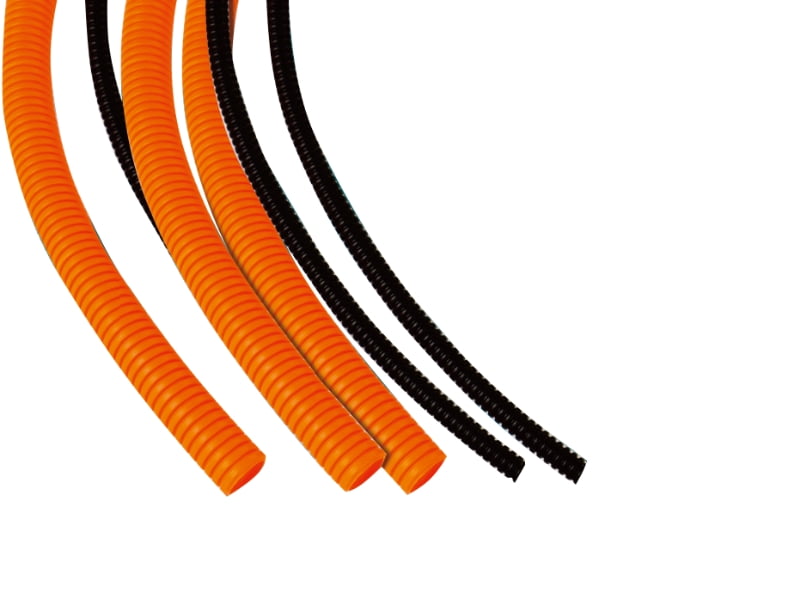ống sóng là gì?
Ống sóng là giải pháp đường ống linh hoạt, nhẹ, đặc trưng bởi lớp ngoài có gờ (gợn sóng) và thành trong nhẵn. Thiết kế độc đáo này mang lại sự cân bằng tối ưu giữa độ bền kết cấu và tính linh hoạt. Các đường gợn sóng tạo ra một loạt các vòng đồng tâm giúp tăng cường độ bền của ống. sức mạnh vòng (thường là 50-100 psi đối với ống hdpe) trong khi vẫn duy trì tính linh hoạt với một bán kính uốn cong tối thiểu gấp 20 lần đường kính ống.
thông số kỹ thuật chính của ống sóng tiêu chuẩn:
vật liệu: polyethylene mật độ cao (hdpe), polypropylene (pp) hoặc pvc
phạm vi đường kính: 2 inch đến 60 inch (50mm đến 1500mm)
độ dày thành: 1,5mm đến 15mm tùy thuộc vào đường kính và mức áp suất
phạm vi nhiệt độ: -40°f đến 180°f (-40°c đến 82°c) đối với hdpe
khả năng chống hóa chất: phạm vi pH từ 2-12 cho hầu hết các ứng dụng
cường độ nén: 1.500-4.000 psi tùy thuộc vào vật liệu và cấu hình
đặc điểm của ống sóng
Thiết kế cấu trúc của ống sóng mang lại một số lợi thế riêng biệt:
tỷ lệ sức mạnh trên trọng lượng cao: cấu hình gợn sóng làm tăng mômen quán tính bằng 300-400% so với các ống trơn có trọng lượng tương đương, cho phép khả năng chịu tải của đất lên tới 100 kn/m².
tính linh hoạt: có thể chịu được độ lệch lên đến 10% đường kính không gây hư hại về mặt cấu trúc, có tính chất phục hồi đàn hồi cho phép trở lại hình dạng ban đầu sau khi biến dạng tạm thời.
hiệu suất thủy lực: nội thất mịn màng duy trì hệ số nhám của Manning (n) là 0,009-0,015, tương đương với ống bê tông, trong khi các đường gợn sóng bên ngoài mang lại lợi ích tương tác giữa đất và ống.
độ bền: ống gân hdpe có một tuổi thọ vượt quá 100 năm với việc lắp đặt đúng cách, chống nứt ứng suất môi trường với Xếp hạng tải trọng kéo không đổi có khía (nctl) >1.500 giờ.
khả năng chống hóa chất: khả năng chống axit, kiềm và muối tuyệt vời với thay đổi trọng lượng <0.5% after 30 days immersion in most chemicals at 20°c.
application scenarios
corrugated pipes serve diverse applications across multiple industries:
stormwater management: used in subsurface drainage systems handling flows up to 1000 gallons per minute (3,785 l/min) in 12-inch diameter pipes at 1% slope.
agricultural drainage: perforated corrugated pipes with slot openings of 0.04-0.08 inches (1-2mm) spaced at 3-6 inch (75-150mm) intervals for subsurface irrigation and field drainage.
road and railway construction: as culvert pipes with aashto m252/m294 compliance, supporting hs20-44 loading when properly embedded.
telecommunications conduit: innerduct systems with 40-60% reduction in cable pulling tension compared to smooth bore pipes.
geothermal systems: closed-loop ground source heat pump applications with thermal conductivity of 0.42-0.51 w/m·k.
mining operations: ventilation ducts with static pressure ratings up to 5 inches wg (1,245 pa) for auxiliary mine ventilation.
maintenance procedures
proper maintenance ensures optimal performance and longevity:
inspection schedule:
quarterly visual inspections for surface damage or deformation
annual cctv inspections for interior assessment (minimum 20 lux illumination and 540 tv lines resolution)
biannual flow capacity verification using ultrasonic flow meters with ±2% accuracy
cleaning methods:
hydrojetting at 1,500-3,000 psi (10-20 mpa) with 4-8 gpm (15-30 l/min) flow rates
mechanical rodding with carbon fiber rods rated for 250 lbs (113 kg) of pushing force
for grease buildup, use ph-neutral enzymatic cleaners (6.5-7.5 ph)
repair techniques:
patch repairs using electrofusion couplings with 2,000 psi (13.8 mpa) tensile strength
cured-in-place pipe (cipp) lining with resin systems achieving 12,000 psi (83 mpa) flexural strength
section replacement following astm f2561/f2561m standard practice
preventive measures:
install sediment traps with 50 micron filtration at inlets
apply uv stabilizers (0.3-0.5% carbon black concentration) for exposed pipes
maintain minimum 12 inch (300mm) cover depth for buried pipes
critical maintenance data points:
maximum allowable deflection: 7.5% of diameter (per astm f2648)
recommended cleaning velocity: 3-5 ft/s (0.9-1.5 m/s)
acceptable ovality limit: ±5% of nominal diameter
joint pull-out resistance: ≥1,000 lbs (454 kg) for 12-inch pipes



 English
English


